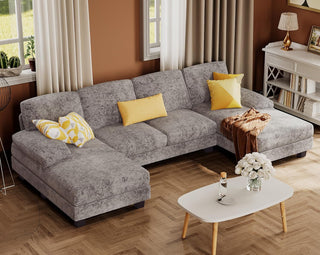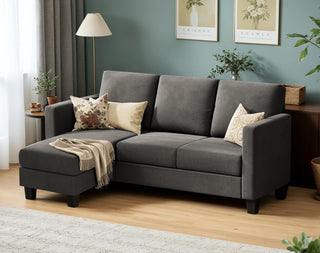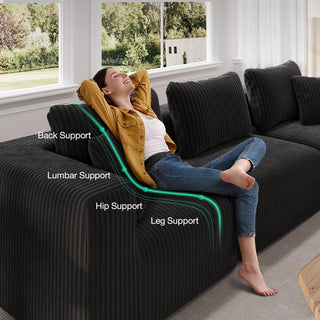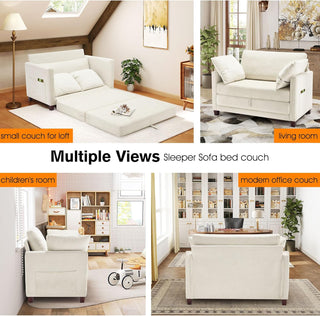Around the world, millions of adults share a bed with a partner. In many Western cultures, bed-sharing is so normalized that couples rarely even consider other sleeping arrangements.
For some couples, sleeping in the same bed works smoothly. In fact, research suggests that there are several benefits of sleeping with a partner, including improved sleep and stronger emotional bonds.
However, for other couples, sharing a bed can actually disrupt sleep. Snoring, grabbing all the blankets, and mismatched sleep schedules can leave one or both partners sleeping poorly. As a result, many couples eventually discover that they are not exactly in sync when it comes to how they sleep together.

Fortunately, there are many effective strategies that can help couples sleep more comfortably. Below, we’ll look closely at both the potential advantages and drawbacks of sleeping with a partner, discuss when a “sleep divorce” may be useful and how it works, and offer practical tips for improving shared sleep.
Keep reading to discover everything you need to know about sleeping as a couple.
Benefits of Sleeping with a Partner
Sleeping next to a partner can provide several meaningful benefits. From morning cuddles to the comforting feeling of closeness, having a loved one nearby can feel reassuring. It may also promote a sense of safety in case of an emergency during the night.
Interestingly, scientific research supports many of these potential benefits. Dr. Kent Smith, President of the American Sleep and Breathing Academy, explains: “A growing amount of evidence shows that couples who sleep together not only remain together, but may also extend their lives.”
Smith highlights three main reasons for this:
-
Stronger relationships.
“Sleeping with a significant other increases oxytocin, a hormone linked to bonding and produced in the same area of the brain that influences the sleep-wake cycle,” Smith says. “Sharing a bed can also strengthen emotional connection and reduce the risk of developing depression or other mood disorders.”
-
Safety and security.
“Sleeping beside someone you love promotes feelings of protection and emotional safety,” he explains. “These calming emotions lower cortisol, the body’s primary stress hormone, supporting more peaceful and restorative sleep.”
-
Better long-term health.
People who maintain consistent and healthy sleep routines are less likely to develop sleep deprivation, which is associated with conditions such as heart disease, obesity, sleep apnea, insulin resistance, slowed reaction times, a weakened immune system, and increased irritability.
Additional research supports the many potential upsides of sleeping with a partner:
-
Increased REM sleep.
A 2020 study found that heterosexual couples who sleep together experience about 10% more REM sleep and less disrupted REM sleep than those who sleep alone. Because REM sleep is crucial for memory and emotional processing, the study suggests that sleeping alongside a partner may support mental health and creative problem-solving.
-
More sleep overall.
A 2015 study found that couples may get more total sleep and fall asleep more quickly when sharing a bed, with fewer nighttime awakenings.
-
Improved perception of sleep.
A 2021 study found that individuals who share a bed often perceive their sleep more positively, even when their actual sleep quality is not ideal.
-
Lower blood pressure.
A 2017 study showed that couples who display strong sleep-wake synchronization may have lower blood pressure and reduced inflammation, supporting heart health and reducing the risk of cardiovascular disease.
-
Earlier detection of sleep disorders.
Many individuals are unaware they have conditions like sleep apnea. Often, a sleep partner notices the signs—such as gasping or snoring—and encourages them to seek treatment.
-
Healthier routines.
Couples who sleep well together may be more likely to maintain consistent bedtimes, exercise regularly, and follow treatment plans for any existing sleep disorders.
Common Sleep Problems and Preferences
Although sleeping together can promote closeness, it is not always the best setup for everyone. Many couples experience sleep challenges caused by differences in needs, sleep styles, or medical issues.

Below are some common causes of sleep-related conflict.
Snoring and Other Sleep Issues
A 2016 literature review found that when sleep issues are present in one or both partners—such as snoring, sleep apnea, or insomnia—sleep quality can decline for both individuals, and these challenges may even contribute to relationship strain.
Interestingly, and perhaps unexpectedly, a sleep disorder in one partner can actually increase the likelihood that the other partner may develop a sleep disorder as well.
There are several strategies that may help reduce snoring. Sleeping in a slightly elevated position or shifting to sleep on one’s side can sometimes lessen the issue. If your partner snores, you might gently encourage them to try sleeping with an additional pillow or turning to the side.
Nasal strips, oral appliances, fans, and white noise machines may also help minimize snoring or mask disruptive sounds. Earplugs can be effective too, provided you are comfortable wearing them.
However, if snoring seems severe, or if you notice that your partner occasionally stops breathing while snoring, it is important to consult a healthcare professional to rule out conditions such as sleep apnea. Many people are unaware that they snore or that they may be experiencing breathing disruptions during sleep.
A proper diagnosis can help ensure the right treatment plan, which may involve using a CPAP machine or oral appliance to keep the airway open during sleep. Therapy can also be beneficial for individuals experiencing insomnia, supporting healthier sleep patterns.
Moving Around
Some people experience a sleep disorder known as restless leg syndrome (RLS), which makes it difficult to find a comfortable position and often leads to significant movement during the night. This movement is commonly an attempt to relieve a “tingling sensation” in the legs or arms.
Others may simply be naturally inclined to toss and turn while sleeping. Regardless of the underlying cause, this type of frequent movement can be highly disruptive to a bed partner.
If you or your partner may be experiencing RLS, it is important to seek medical evaluation. Sometimes an underlying health condition triggers RLS, and treating that condition can bring noticeable relief for both partners. A doctor may also recommend medication specifically aimed at reducing RLS symptoms.
Additional ways to help manage RLS include engaging in regular physical activity, massaging the legs, using hot or cold packs, and reducing or avoiding caffeine and tobacco.
For general restlessness, one effective option couples can consider is investing in a mattress that provides strong motion isolation, such as a memory foam mattress. Beds with low motion transfer help ensure that the partner who tends to move during sleep is less likely to disturb the other individual. For more guidance, look into recommendations for the best mattresses for couples that prioritize motion control and shared sleep comfort.
Different Temperature Preferences
Some couples are fortunate enough to share similar temperature preferences, while others differ completely when it comes to the ideal sleep environment.
This is a common point of tension in relationships: One partner may prefer to sleep beneath multiple blankets or with the thermostat turned up, while the other feels most comfortable with just a light sheet or a room that is kept quite cold.

Sleep experts generally agree that a cooler bedroom—typically between 60 and 67 degrees Fahrenheit—supports more restful sleep. However, this does not mean that one partner has to compromise their comfort entirely.
Couples with different temperature needs can try separate bedding arrangements, allowing each person to control warmth on their own side of the bed. Another option is to direct a fan toward the partner who sleeps hotter, while keeping airflow away from the partner who prefers more warmth.
Additionally, one partner may choose to wear warmer sleepwear, such as flannel pajamas, while the other opts for a lightweight, breathable t-shirt. Smith notes that cotton sleepwear is particularly beneficial because it is breathable and helps prevent overheating during the night.
Noise and Tech Use
Many people find it relaxing to fall asleep while watching TV or listening to music, while others need complete silence in order to drift off. A 2021 study involving 289 cohabitating adults found that individuals often feel frustrated when their partner chooses to watch TV alone instead of engaging in physical or emotional intimacy before bed.
Conversely, the same study noted that partners who watch TV or use technology together before going to sleep tend to feel more satisfied with their sleeping arrangement.

If you and your partner differ on the need for noise at bedtime, there are ways to compromise. The partner who prefers using technology before sleep could try wireless TV headphones or headband-style sleep headphones to avoid disturbing the other. Using a TV with a sleep timer may also be beneficial—but remember to lower the screen brightness, as blue light from TVs and electronic devices can negatively affect your sleep quality.
Light Usage
Light is another common area where couples may disagree when it comes to sleep preferences. Some people feel most comfortable sleeping in complete darkness, while others require a nightlight or a gentle light source in order to fall asleep comfortably.
Individuals who struggle with insomnia sometimes turn on a light to read or engage in another quiet activity during the night, but this can be disruptive to their partner’s rest.
One practical solution is for the partner who prefers a darker environment to use an eye mask, which can help block out light (and research supports the sleep benefits of wearing an eye mask). Those who like to read before bed might also choose a small, dim book light rather than using a bright lamp or overhead light, helping to maintain a more restful atmosphere for both partners.
Opposing Bedtime and Wake Times
You and your partner may have different bedtime and wake times for a variety of reasons, including work schedules, responsibilities with children or pets, or simply personal preference. One person may be a night owl, while the other is naturally more of a morning person.
The 2016 review referenced earlier found that mismatched sleep-wake cycles can result in poor or insufficient sleep for one or both partners. Interestingly, the research noted that women, in particular, tend to prefer partners who share similar sleep patterns.
While life demands may not always make it possible to fully synchronize your sleep schedules, it can still be beneficial to work toward alignment when it’s realistic. Research indicates that couples with misaligned sleep routines report lower relationship satisfaction than couples who go to bed around the same time.
However, if matching sleep schedules is simply not feasible, the key is to respect each other’s sleep needs so both partners are able to rest adequately.
Early risers should try to avoid turning on bright lights or making noise in the bedroom before their partner wakes. A helpful strategy is using a vibrating alarm placed inside a pillow, so the wake-up call is quiet and does not disturb the other person.
Meanwhile, night owls can show consideration by dimming lights, silencing electronics, or using headphones when their partner decides to go to bed.
Illness
Most of us have experienced illness at some point. Whether the condition is short-term or chronic, being sick can make it more difficult for one or both partners to sleep comfortably through the night—this is especially common during colds or viral infections.
The 2016 review mentioned earlier found that the early stages of illness tend to be particularly disruptive, as both partners work to adjust to new sleep needs and physical limitations.
A straightforward solution during short-term illness is for the healthy partner to sleep in a guest room or on the couch. This can help both partners rest better and may also reduce the risk of the healthy partner becoming infected if the illness is contagious.
For chronic illness, it may still be possible for both partners to share the same bed with a few thoughtful adjustments. This could include using an adjustable bed that allows each person to select their preferred firmness, or keeping the same mattress but adding pillows for extra support or opting for breathable bedding to improve comfort.
In some situations, couples may decide to sleep in separate beds or bedrooms on a more permanent basis. For additional details on this approach, refer to the “Sleep Divorce” section below.
Relationship Conflicts
The 2009 and 2016 reviews referenced earlier found that the quality of a relationship—or the lack of it—can significantly influence each partner’s ability to sleep well.
According to these reviews, individuals in distressed relationships are more likely to experience sleep disturbances and have a higher likelihood of developing sleep disorders.
This may stem from anxiety or depression triggered by ongoing conflict, both of which are strongly associated with reduced sleep quality. In turn, poor sleep can heighten irritability, increasing the chance of further conflict, creating a cycle that perpetuates relationship strain and sleepless nights.
If you and your partner are frequently arguing, seeking couples therapy could be beneficial. Practical solutions like using earplugs may also help if noise—such as a TV or snoring—is disrupting your sleep and causing additional tension.
However, if there is little or no improvement despite genuine attempts to resolve issues, it may be necessary to re-evaluate the relationship. Your mental well-being and sleep health are essential and deserve to be protected.
Establishing a Sleep Routine with Your Partner
Some couples naturally share the same sleep habits, but if you and your partner differ in your sleep schedules or sleep preferences, it becomes important to create a routine that feels fair to both individuals. Doing so can also strengthen your relationship. For couples with differing sleep patterns, it is especially helpful to set aside intentional time to connect in the evening before the first partner goes to bed.
Balance is essential when developing a shared sleep routine. For example, if one partner enjoys watching TV to unwind before sleep, while the other needs complete darkness and quiet, there are ways to meet in the middle. The partner who watches TV can use wireless headphones to avoid disturbing the other, while the partner who prefers darkness can wear an eye mask to maintain their preferred sleep environment.
Sleep Tips for Couples

Here are several additional strategies to try before deciding on a sleep divorce.
-
Identify and manage underlying health conditions.
If one or both partners experience snoring, sleep apnea, insomnia, restless leg syndrome, or other sleep-related health issues, it’s wise to consult with a medical professional. Sleeping in a slightly elevated position using a high-quality pillow may also help reduce snoring.
-
Practice proper sleep hygiene.
Whether you sleep with a partner or alone, maintaining good sleep hygiene significantly increases the likelihood of restful sleep. This includes keeping the bedroom cool, dark, and quiet, minimizing electronics in the sleep space, regularly changing bedding, establishing a calming bedtime routine, and going to bed at a consistent time each night.
-
Use separate bedding.
Many couples prefer different amounts or types of bedding. If you share a queen or king mattress, a simple solution is to use individual bedding on each side of the bed. Smith recommends choosing bedding made of natural materials like cotton, which can help prevent overheating. If one partner tends to hog the covers, consider using a Big Blanket, which provides enough coverage for both individuals.
-
Modify the temperature.
If one person tends to sleep hot while the other sleeps cold, you can place a fan on the side of the person who overheats. If both partners sleep hot, consider using copper-infused sheets, which can create a cooler sleeping surface.
-
Invest in the right mattress.
Having the best mattress for your combined needs can significantly improve both sleep quality and the overall relationship. If one partner tosses and turns frequently, a mattress with low motion transfer can help prevent disturbances. A mattress for combination sleepers is also useful for partners who change positions throughout the night. Regardless of sleeping arrangements, maintaining intimacy remains essential, and choosing a mattress that also supports sexual comfort can be beneficial.
-
Use sleep aids.
There are many products designed to enhance sleep quality—blackout curtains can reduce bedroom light, sleep masks allow one partner to enjoy darkness, and earplugs or white noise machines can block distracting sounds. Often, an affordable solution such as a $15 sleep accessory can dramatically improve sleep without needing to sleep separately.
-
Consider sleeping naked.
Smith notes that sleeping nude carries several benefits, including better temperature regulation, enhanced intimacy, a higher sperm count, a lowered risk of yeast infections, and more restorative sleep. Additionally, skin-to-skin contact increases the hormone oxytocin, which supports emotional and physical bonding. Lying next to your partner without clothing can also boost sexual desire, fostering deeper intimacy.
The Best Sleeping Positions for Couples
Sleep positions can also become a source of tension in a relationship. Perhaps you prefer to sleep on your back, while your partner stretches out spread-eagle on their stomach and frequently kicks their leg into yours. Or maybe you both enjoy sleeping on your sides facing one another, which can mean repeatedly waking up to less-than-pleasant morning breath.
Sharing a bed with a partner may require you to adopt a sleep position that feels unfamiliar. Most adults naturally change positions several times throughout the night. On average, people spend approximately 54% of the night sleeping on their side, a little more than 37% on their back, and around 7% on their stomach. If sleeping together prevents you from adjusting positions comfortably, you may experience stiffness or discomfort upon waking.
Sleeping in Separate Beds (Sleep Divorce)
Recent research indicates that nearly half of Americans would prefer to have their own bed. When couples struggle to get high-quality sleep in the same space, it may be worth considering sleeping separately. Below are the pros and cons of this approach.
What Is Sleep Divorce?
A “sleep divorce” refers to couples choosing to sleep in separate spaces or different bedrooms, while maintaining the rest of their relationship as usual.
Although the idea may initially seem extreme, it is becoming increasingly common among American couples. As referenced earlier, 47% of survey respondents said they would prefer to sleep without their partner, and 19% reported blaming their partner for their poor sleep.
There are many reasons why one or both partners may opt to sleep separately. The study identified several frequent motivations for seeking a sleep divorce, including being disturbed by snoring, fighting over blankets, overheating during the night, and waking up with the other person’s hair in their face.
Pros and Cons of Sleeping In Separate Beds
Sleeping in separate beds presents both potential benefits and drawbacks.
In many situations, a sleep divorce can actually increase the likelihood that both partners will get higher-quality rest, making this arrangement a mutually beneficial option when sleep issues are present.
Consistently obtaining quality sleep is essential, since sleep deprivation is linked to a wide range of physical and mental health concerns, including type 2 diabetes, depression, reduced work performance, and lowered relationship satisfaction.
Improved sleep often comes from removing the factors that disrupt rest—such as snoring, blanket hogging, or frequent movement. Some couples even notice that their sexual intimacy increases when they stop sharing a bed, since the added separation may make physical connection feel more intentional and exciting.
If you and your partner decide to try a sleep divorce, it is important to communicate openly throughout the entire process. Sleeping apart may cause one or both partners to feel lonely or insecure, so make space for emotional check-ins. Consider setting a trial timeline, then evaluate together whether the arrangement should continue.
If you choose to maintain separate sleeping spaces, plan time for emotional closeness and sexual intimacy. Spending time together before bed, such as watching TV or reading side-by-side before going to separate rooms, can help maintain the same sense of connection that sleeping in the same bed can provide.
The Takeaway
Some couples truly enjoy sleeping together in the same bed, while others discover that sleeping separately can provide significant benefits for both their relationship and their sleep quality. If you and your partner are experiencing difficulty sleeping or finding that sharing a bed is challenging, our couples sleep guide offers many helpful strategies to support a more restful night’s sleep.
And if these techniques still don’t resolve the issue, there is absolutely nothing wrong with prioritizing your sleep health and choosing to pursue a sleep divorce. Just make sure to communicate openly as a couple, discussing the potential advantages and disadvantages of this decision together.
FAQs
Is it OK to sleep apart as a couple?
Yes. If sleeping apart leads to better sleep quality or improves your relationship, then keeping separate beds is perfectly acceptable. Sleep is a vital component of your overall health and daily functioning.
However, if sleeping separately feels upsetting or uncomfortable for one or both partners, it’s important to communicate openly. Discuss your individual sleep needs and the reasons why separate beds may be beneficial. Be respectful and attentive to each partner’s concerns, and work together to determine the best solution for both of you.
How should couples sleep at night?
There is no single correct way for couples to sleep. Spooning can provide warmth and closeness on cooler nights, while sleeping side-by-side on your backs allows for personal space and reduced disturbance.
Ultimately, the ideal arrangement is whichever sleep position or setup feels comfortable and results in restful sleep for both partners.
Do couples sleep better together or apart?
Most research suggests that many couples tend to sleep better together, but the answer depends on each couple’s unique sleep habits and needs. For example, if one or both partners snore or move frequently during sleep, they may actually sleep more soundly when sleeping separately rather than sharing the same bed.








 https://dweva.com
https://dweva.com























